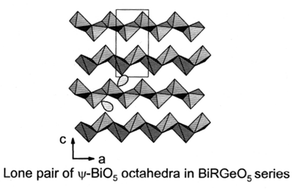Colored crystals of the middle term (a
= 1) of the Bi2−aRaGeO5 series (R = Y (yellow), Yb (brown)) have been grown. The structure of these materials has been established by single-crystal X-ray diffraction. They are isostructural and crystallize in the orthorhombic system, space group Pbca
(No. 61), Z
= 8, with unit-cell parameters a
= 5.341(8) and 5.315(2), b
= 15.232(2) and 15.225(2), c
= 11.084(3) and 11.025(2)
Å, for R = Y and Yb respectively. The structure is formed by [GeRO5]∞ layers containing both (RO7)6 units and GeO4 tetrahedra. Between these layers zig-zag chains of ψ-BiO5 octahedra run in the a direction. The stereoelectronic effect of the Bi3+ lone pair leads to this apparent zig-zag, and therefore to the kind of packing observed in this new type of structure. The downward deviation in the molar magnetic susceptibility of BiYbGeO5 from the Curie–Weiss behavior, observed at low temperatures, is attributed to the effect of the crystal field splitting of the 2F7/2 ground term of Yb3+. Energies of the maximum phonon, 799 and 797 cm−1 for Y and Yb materials, respectively, have been determined from room temperature Raman scattering spectra of polycrystalline samples.

You have access to this article
 Please wait while we load your content...
Something went wrong. Try again?
Please wait while we load your content...
Something went wrong. Try again?


 Please wait while we load your content...
Please wait while we load your content...